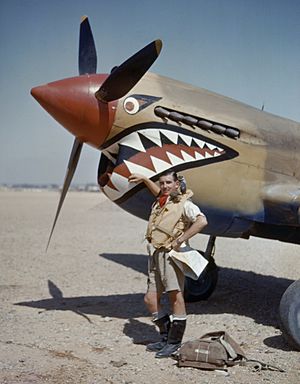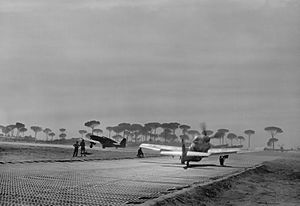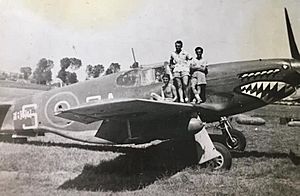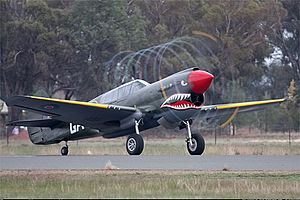No. 112 Squadron RAF facts for kids
Quick facts for kids No. 112 Squadron |
|
|---|---|

1943: A Kittyhawk Mark III of 112 Squadron, taxiing through scrub at Medenine, Tunisia. The "erk" sitting on the wing is directing the pilot, who cannot see past the aircraft's nose.
|
|
| Active | 30 July 1917 – 13 June 1919 16 May 1939 – 30 December 1946 12 May 1951 – 31 May 1957 1 August 1960 – 31 March 1964 2 November 1964 – 1 July 1975 |
| Country | |
| Branch | |
| Nickname(s) | "The Shark Squadron" |
| Motto(s) | "Swift in Destruction" |
| Battle honours | Home Defence 1917–1918, Egypt 1940, Greece 1941, Western Desert 1941–43, Italy 1943 |
| Commanders | |
| Notable commanders |
Clive Caldwell; Billy Drake |
| Insignia | |
| Squadron Badge heraldry | "A cat sejant". |
| Squadron codes | XO May–Sep 1939 RT 1940 – Jun 1941 GA Jun 1941 – Dec 1946 T May 1951 – Jul 1953 A Jul 1953 – Jan 1954 |
No. 112 Squadron was a famous unit of the Royal Air Force (RAF). It flew in both the First World War and Second World War. It was also active for three periods during the Cold War. This squadron is known as "The Shark Squadron". This nickname came from being the first Allied air force unit to paint a "shark mouth" logo on its Curtiss P-40 planes.
Contents
First World War Service
The squadron started as No. 112 Squadron of the Royal Flying Corps. This happened on July 30, 1917, in Kent, England. Its job was to defend the London area from air attacks.
At first, the squadron used Sopwith Pup planes. In 1918, they received Sopwith Camel aircraft. One of its early leaders was Major Quintin Brand. He later became a high-ranking commander during the Battle of Britain.
In the summer of 1918, the best pilots formed No. 151 Squadron. This new group went to France. They flew Camels at night, attacking German airfields. After the war ended, the squadron was closed down on June 13, 1919.
Second World War Adventures
No. 112 Squadron was started again on May 16, 1939. Its members sailed on the aircraft carrier HMS Argus to serve in Egypt. They were first based at RAF Helwan near Cairo.
On May 26, a part of the squadron, "B" Flight, was sent to Sudan. The squadron finally got its planes, older Gloster Gladiator biplane fighters, in June. When Italy joined the war on June 10, 1940, the squadron quickly went into action. They defended Egypt from Italian bombers.
In January 1941, the squadron joined Allied forces in the Battle of Greece. They provided air cover and support over Albania. Later, they fought in air battles to defend Athens. When the Allied campaign in Greece failed, 112 Sqn moved to Crete. Then they went back to Egypt. From there, they rejoined the North African Campaign, helping the Eighth Army. For much of the war, the squadron was part of No. 239 Wing. Other squadrons in this group included No. 3 Squadron RAAF and No. 250 Squadron RAF.
In July 1941, the squadron was one of the first in the world to use the Curtiss Tomahawk. They used it as a fighter and a fighter-bomber. The P-40 had a very large air intake. This inspired the squadron to copy the "shark's mouth" logo. German Messerschmitt Bf 110 planes had used this design earlier in the war. Other P-40 units, like the famous Flying Tigers, later copied this shark mouth design.
In December, the Tomahawks were replaced by the better P-40 Kittyhawk. The squadron used Kittyhawks for the rest of its time with the Desert Air Force. They often used them as fighter bombers.
The squadron had many pilots from different countries. These included Poland, Australia, Canada, and New Zealand. A famous British pilot named Neville Duke also flew with them. For most of 1942, the squadron was led by Clive Caldwell. He was the top Australian pilot of World War II. He was also the first pilot from the British Commonwealth Air Training Plan to lead a British unit. Billy Drake took over from Caldwell. Drake was the top RAF P-40 pilot. Later in the war, more pilots from South Africa joined the unit.
After the invasion of Sicily on July 10, 1943, the squadron moved to the island. They then moved to the Italian mainland in September. In June 1944, the Kittyhawks were replaced by North American Mustang Mark III planes. From February 1945, they used Mustang Mk IVs.
The squadron stayed in Italy at Lavariano as part of the forces occupying the area. It was finally closed down on December 30, 1946, at Treviso. By the end of the war, the squadron had claimed 206 air victories. They also destroyed 62 enemy planes on the ground.
Cold War Missions
The squadron was formed again in Germany on May 12, 1951. It was given the job of fighter bomber, using de Havilland Vampire Mk 5s. It later moved to Jever and then RAF Bruggen. In January 1954, it became a day fighter unit. Its Vampires were replaced by Canadair Sabre F Mk IVs. Hawker Hunters were given to 112 Sqn in April 1956. But the unit was closed down at Bruggen on May 31, 1957.
On August 1, 1960, the squadron was formed again. This time, it was a Bloodhound surface-to-air missile unit. It was based at RAF Church Fenton. Its job was to defend Thor IRBM missile sites in the area. The squadron's main base was at RAF Breighton. When the Thor missiles were no longer used, the unit was not needed as much. It was closed down on March 31, 1964.
However, 112 Sqn was formed one more time on November 2, 1964. It was at RAF Woodhall Spa and used Bloodhound Mk 2 missiles. The squadron moved to Cyprus on October 1, 1967. It stayed there until it was closed down for good on July 1, 1975.
Aircraft Operated by 112 Squadron
- 1917–1918 – Sopwith Pup
- 1918–1919 – Sopwith Camel
- 1919 – Sopwith Snipe
- 1939–1941 – Gloster Gladiator I & II
- 1940–1940 – Gloster Gauntlet
- 1941 – Hawker Hurricane I
- 1941 – Curtiss Tomahawk I
- 1941 – Curtiss Tomahawk IIA & IIB
- 1941–1942 Curtiss Kittyhawk 1A
- 1942–1944 Curtiss Kittyhawk III
- 1944 Curtiss Kittyhawk IV
- 1944–1945 North American Mustang III
- 1945–1946 North American Mustang IV
- 1951–1954 de Havilland Vampire FB5
- 1954–1956 Canadair Sabre F4
- 1956–1957 Hawker Hunter F4
- 1960–1964 Bristol Bloodhound I
- 1964–1975 Bristol Bloodhound II
See also
- List of Royal Air Force aircraft squadrons





